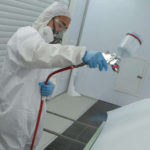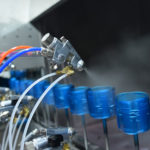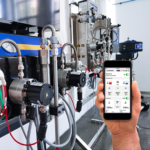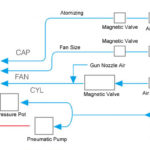
The work principle of electrostatic powder coating is almost the same as liquid electrostatic coatings, except that powder spraying is dispersed not atomized. It is a coating sprayed by an electrostatic powder spray gun. While dispersing, the powder particles are negatively charged. The charged powder particles are processed by air flow (or other forces such as centrifugal) and electrostatic attraction to be coated on workpiece. Then heated to melt and solidify to form a hard film. Electrostatic powder coating is primary choice for lost of hardware coating projects.
Electrostatic Powder Coating Advantage
Electrostatic powder coating is popularly known as “plastic powder spraying“.
Electrostatic powder coating is powered by a coating machine with an atomizing nozzle (to atomize the powder) and a discharge level (to generate electricity and current) to atomize the powder and apply charge to it to form an electric field between electrode and the object to be coated. Powder is coated by electrostatic attraction.
Main features: spraying method can be manual, automatic or manual + automatic. The spray material is 100% solid powder that can be recycled, the powder recycling efficiency can reach 98%. High grade automation by hang conveyor system. The coating has less micropores with good anti-corrosion performance, and can be used for one time thick film painting.
Electrostatic Powder Coating Process Flow
Use electrostatic powder spraying equipment (electrostatic spraying machine) to spray powder coating on workpiece surface. Under the action of static electricity, the powder will be evenly adsorbed on the surface to form a powdery coating. Flat curing, turning into a final coating with different effects (by different kinds powder coatings).
Before powder coating spray, we need apply crucial pretreatment process in order to get expected performance. Depends the actual workpiece properties, various treatment solutions can be used. Here we briefly introduce the required condition for powder coating and it’s general technique.
1.Pre-treatment
Purpose: to remove oil stains, dust, and rust on workpiece surface, and to form a “phosphating layer” or “chromizing layer” on the surface that is resistant to corrosion and can increase the adhesion of coating. Main process steps include: oil removal, rust removal, phosphating (chromization), passivation. After pretreatment, not only the surface is free of oil, rust, and dust, but also a uniform and rough gray phosphate film (chromized film) that is not easy to rust formed on the original surface, which can also increase the adhesion of spray coating.
There are three types of pretreatments: immersion type, spray type and waterfall type. The immersion type requires multiple tanks; spraying requires a spray chamber on painting line; waterfall type means that the solution flows down from the height directly along the workpiece.
2. Electrostatic spraying
Purpose: uniformly spray powder coating on workpiece surface. Special workpieces (including locations prone to electrostatic shielding) should be sprayed with a high-performance electrostatic spray machine.
Process steps: The electrostatic adsorption principle is used to uniformly spray a layer of powder coating on workpiece; the fallen powder is recovered through a recovery system.
3.Curing
Purpose: To solidify the sprayed powder on workpiece.
Process steps: Put the sprayed workpiece in a high-temperature furnace at about 200 °C for 18-20 minutes (curing temperature and time depend the quality of selected powder, some low-temperature powder curing temperature is about 160 ° C, which saves energy a lot), so that the powder is melted, leveling and solidified.
Common Problems and Solutions in Powder Coating
Coating shrinkage
1) The degreasing in pretreatment is not clean or the rinse is not clean after degreasing. The solution is to control the concentration and proportion of the pre-degreasing tank and degreasing tank liquid, reduce the oil content on workpiece, and strengthen the washing effect.
2) Shrinkage caused by excessive oil content in water. The solution is to increase the water inlet filter to prevent oil leakage from water supply pump.
3) Shrinkage caused by excessive moisture content in compressed air. The solution is to drain the compressed air condensate in time.
4) Shrinkage caused by wet powder. The solution is to improve the powder storage and transportation conditions, add dehumidifier and ensure the recovered powder is used in a timely manner.
5) Shrinkage caused by oil pollution on the suspension chain caused by air-conditioning blown onto the workpiece. The solution is to change the position and direction of air outlet.
6) Shrinkage caused by powder mixing. The solution is to thoroughly clean the booth system when switching to another powder.
Coating color difference
1) Color difference caused by uneven distribution of powder pigment. The solution is to improve the quality of the powder, to ensure that the L, a, and b of the powder are not significantly different and that the positive and negative are uniform.
2) Color difference caused by different curing temperature. The solution is to control the set temperature and conveyor chain speed to maintain the consistency and stability of the workpiece curing temperature and time.
3) Color difference caused by uneven coating thickness. The solution is to adjust the powder spraying parameters and ensure the powder spraying equipment runs well so coating thickness will be uniform.
Poor coating contact
1) Inadequate pre-treatment water washing can cause poor adhesion due to residual degreaser, chrome slag on the workpiece, or contamination of the washing tank with alkali. The solution is to strengthen water washing, adjust the degreasing process parameters, and prevent the degreasing liquid from entering the phosphated water washing tank.
2) Poor contact by yellowing, flowering or partial non-phosphorizing film of the phosphate film. The solution is to adjust the concentration and ratio of the phosphating bath and increase the phosphating temperature.
3) Poor contact due to moisture drying at the corners of workpiece. The solution is to increase the drying temperature.
4) Poor contact of large area of coating due to insufficient curing temperature. The solution is to increase the curing temperature.
5) Poor contact caused by excessive oil content and salt content in deep well water. The solution is to increase the water inlet filter and use pure water as the last two washing stages.
There are many electrostatic powder coating spraying techniques and their application methods, which need to be flexibly used in practice.




